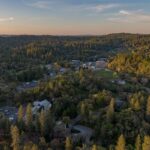Climate Change in the Sierra-Cascade
Mixed conifer forests of California’s Sierra-Cascade region play a significant role in regulating the climate. For thousands of years, they have absorbed carbon from the atmosphere and store enormous amounts both above and below ground.
Today’s overcrowded forests absorb less carbon and are prone to damaging wildfires that release large amounts of carbon back into the atmosphere. Research indicates that unhealthy forests may pose a greater risk to California’s climate goals than once presumed. Forest restoration treatments ultimately increase carbon sequestration and move carbon stores to larger, more fire-resilient trees.
Read more about climate change in the Sierra-Cascade.

















